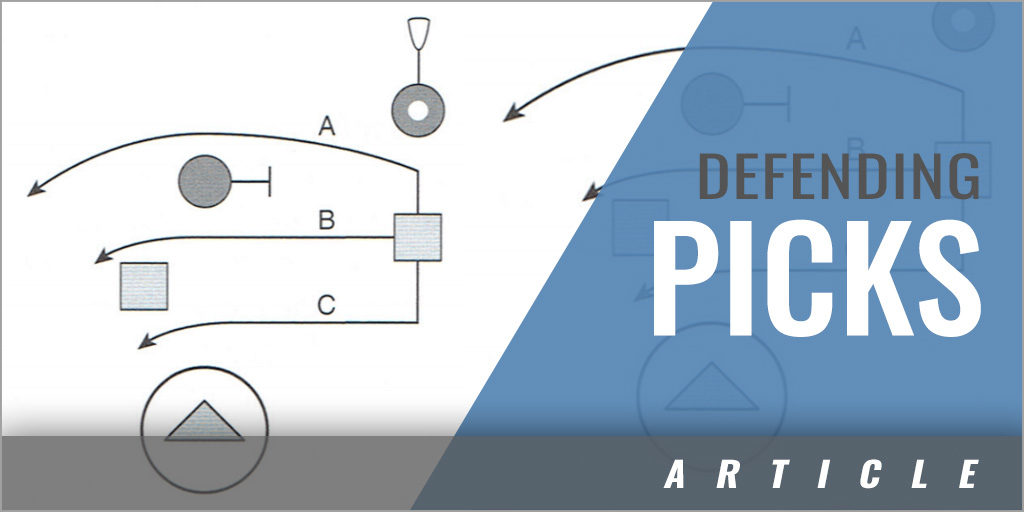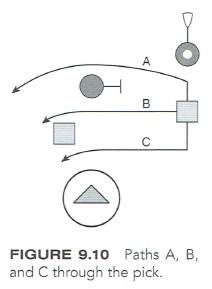|
By: Don Zimmerman and Peter England Originally Published in: Men's Lacrosse Provided by: Human Kinetics Picks and posts are screens used by offensive players to block a defender. One offensive player positions his body near a teammate's defender in order to obstruct that defender. The other offensive player uses the pick to get free for a dodge, feed, or shot. Off-ball defenders must identify a pick, communicate a pick, and negate its impact. Picks come in two varieties: on-ball and off-ball picks. In the case of an on-ball pick, the play involves the additional component of a defender playing a ball carrier and using on-ball techniques. Both on-ball and off-ball picks are discussed here because what makes the pick play unique is the off-ball pick setter. Sometimes the pick user has the ball, and sometimes he doesn't. In an on-ball pick situation, a ball carrier is using the pick. In an off-ball situation, a cutter is using a pick for a feed. In either case, the defense typically wants to open a lane and let the defender get through the pick and not switch. However, as a defender, you may have to switch, especially when you are closer to the goal. Both the defender playing the ball and the defender playing the pick setter will shadow their men and play sides as the pick develops. The former is ready to switch, and the latter is preventing the pull-back move. Defenders' Roles on Picks The defender roles discussed in this section apply to picks in both the attack zone and the midfield zone. You can afford to have a cushion on a pick behind the goal or out top. If your man sets a pick in the attack zone, you can afford to be 1 1/2 yards below the pick because your man can't score. When you go underneath a pick, you can give the attacker a wider cushion because he can't score but he has his hands free in the most dangerous feeding area of the field. If your man sets a pick in the midfield zone (10 to 12 yards above the crease), you can afford to be 1 1/2 yards below the pick because your man is not dangerous as a shooter. If you're the defender playing the pick user, you should run with your man and give him a cushion, especially on a sweep. You shouldn't try to be all over your man, because if he shoots the ball and you're within a stick's length, you can get a piece of his gloves and cause a turnover (bad shot). You can afford to give your man a cushion and get through a lane on a pick because he is not dangerous as a shooter. If you're the defender playing the pick setter, be aware that your opponent is not in a real dangerous area, so you can afford to give him a 1 1/2-yard cushion. You can drop back and create an open pick lane for your teammate. You give your man that much cushion because you can switch if necessary and you can close down on your man if he receives the ball. If you are the defender playing the pick setter, your first task is recognizing and communicating a pick. If your man sets a pick, you should shadow or trail him to minimize a front swing or backdoor cut, and you should be ready to switch. You must communicate the pick to your teammate by using concise and descriptive language such as "Pick left" or "Pick right." You should keep repeating the call (instead of just calling out one time). Ideally, you want to create an open lane for your teammate to run through the pick. You create a 1 1/2-yard cushion below the pick and a 1 1/2-yard cushion to the off-ball side of the pick. If you have to switch, then you're already two steps ahead of the man with the ball, and you are stepping up into his path to the goal. If you don't position yourself 1 1/2 yards below the pick, you become a double pick. If you don't position yourself 1 1/2 yards to the off-ball side, you will be trailing the man with the ball if you have to switch. By rule, your man has to be stationary when setting the pick, but you don't want to be stationary. If you stop and then have to switch, you can't expect to go from a standing still position to effectively covering another man who is sprinting by you. As your man sets the pick, you are already anticipating the switch and moving away from the pick (cheating for the switch). You use your momentum to be leaning and moving in the direction of the oncoming ball carrier. You are ready to explode in that direction. When your man sets the pick, you're ready to recover. You drop-step and open up your hips so you can run hip to hip and match the opponent's speed. This also gives you the angle you need to take in order to get on your attacker. When your teammate gets near the pick, you have to decide whether you want him to stay or switch. "Get through" tells your teammate to take the open lane through the pick and not switch. You lift your stick vertically to allow your teammate to get through the pick smoothly. "Ready" tells your teammate that you are going to switch (e.g., "Pick left, ready, ready"). The defensive rule is that only the defender whose man is setting the pick can initiate a switch call. Note that a "help" call is the only time that the defender playing the ball can initiate a switch. The defender whose man is using the pick may make a "help" call if he falls down or loses the ball carrier and can't recover. This defender will call "Help," which means SWITCH. You should always expect the worst on defense (e.g., open lane closes down on the pick, teammate gets picked off). If your man sets a pick, you should always anticipate the switch and anticipate changing direction but keep your feet moving. You need to be in the proper field position to effectively play the ball once you do switch, and you want to use your momentum to your advantage. If you are the defender playing the pick user, your first task is recognizing the pick. You hear your teammate yell, "Pick left" or "Pick right." Once you recognize a pick, you drop-step and open up your hips so you can see the pick coming and can run hip to hip. If your man sprints, you can run hip to hip (not a shuffle) and match your man stride for stride. You shadow or trail your opponent toward the pick to minimize a pull-back or cut-back move. If your opponent slows down, then you slow down (you should mirror your man). You lift your stick vertically so it doesn't get caught up with the pick. Your job is to choose the optimum path through the pick (see figure 9.10):
|



 If you go underneath the pick in the attack zone, your opponent can step back and pop out to be a feeder. You have to close that gap or cushion. You close down the distance, move your stick from a port to a poke position, and get into the opponent's gloves. However, by closing down the distance, you are stepping away from the goal. Whenever you step away from the goal or GLE, you leave yourself vulnerable to a dodge. You don't want to turn a feeder into a dodger. If you go underneath the pick in the midfield zone and your opponent pops out, he will be 15 yards out and not in a position where he can
If you go underneath the pick in the attack zone, your opponent can step back and pop out to be a feeder. You have to close that gap or cushion. You close down the distance, move your stick from a port to a poke position, and get into the opponent's gloves. However, by closing down the distance, you are stepping away from the goal. Whenever you step away from the goal or GLE, you leave yourself vulnerable to a dodge. You don't want to turn a feeder into a dodger. If you go underneath the pick in the midfield zone and your opponent pops out, he will be 15 yards out and not in a position where he can


